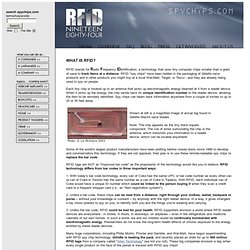

News and feature articles from all fields of science. How to (seriously) read a scientific paper [a serious take] Adam Ruben’s tongue-in-cheek column about the common difficulties and frustrations of reading a scientific paper broadly resonated among Science Careers readers.
![How to (seriously) read a scientific paper [a serious take]](http://cdn.pearltrees.com/s/pic/th/seriously-scientific-paper-184245129)
Many of you have come to us asking for more (and more serious) advice on how to make sense of the scientific literature, so we’ve asked a dozen scientists at different career stages and in a broad range of fields to tell us how they do it. Although it is clear that reading scientific papers becomes easier with experience, the stumbling blocks are real, and it is up to each scientist to identify and apply the techniques that work best for them.
The responses have been edited for clarity and brevity. How do you approach reading a paper? I start by reading the abstract. More from our How-To series I first get a general idea by reading the abstract and conclusions. If I’m aiming to just get the main points, I’ll read the abstract, hop to the figures, and scan the discussion for important points. How to read a scientific paper (a comedic take) Nothing makes you feel stupid quite like reading a scientific journal article.

I remember my first experience with these ultra-congested and aggressively bland manuscripts so dense that scientists are sometimes caught eating them to stay regular. I was in college taking a seminar course in which we had to read and discuss a new paper each week. And something just wasn’t working for me. Every week I would sit with the article, read every single sentence, and then discover that I hadn’t learned a single thing.
I’d attend class armed with exactly one piece of knowledge: I knew I had read the paper. It reminded me of kindergarten, when I would feel proud after reading a book above my grade level. A few weeks into the seminar, I decided enough was enough. I placed the paper on a large empty desk. GCSE Physics - The electromagnetic (EM) spectrum - Revision 3. Electromagnetism. Electromagnetism is a branch of physics involving the study of the electromagnetic force, a type of physical interaction that occurs between electrically charged particles.

The electromagnetic force usually exhibits electromagnetic fields such as electric fields, magnetic fields and light, and is one of the four fundamental interactions (commonly called forces) in nature. The other three fundamental interactions are the strong interaction, the weak interaction and gravitation.[1] The word electromagnetism is a compound form of two Greek terms, ἤλεκτρον ēlektron, "amber", and μαγνῆτις λίθος magnētis lithos,[2] which means "Μagnesian stone",[3] a type of iron ore.
Electromagnetic phenomena are defined in terms of the electromagnetic force, sometimes called the Lorentz force, which includes both electricity and magnetism as different manifestations of the same phenomenon. There are numerous mathematical descriptions of the electromagnetic field. History of the theory[edit] Uses or Simple Applications of Electromagnetism in Technology and Life. Written by: sriram balu • edited by: Swagatam • updated: 12/1/2011 Electromagnetism has created a revolution not only in the field of engineering, but also in various other fields like medicine, space, construction etc.

Read here to know about various uses of electromagnetism in everyday life from household appliances to research labs. Uses of Electromagnetism in LifeWhatever powered devices we use, from table clocks to microwave ovens, have some form of electromagnetic principle involved in their functioning. It is electromagnetism which has given the flexibility for switching of/on electricity as required.Electromagnets are created by having an iron core wound with a conductor carrying current.
The strength of the electromagnet depends upon the amount of current passing through the conductor. Electricity and Magnetism. Electromagnetic Energy: From Motors to Lasers. Facts About Maglev. Magnetic levitation transport, or maglev, is a modern form of transportation that suspends, guides and propels vehicles (especially trains) via electromagnetic force.

This High-Tech method can be significantly faster than wheeled mass transit systems, potentially reaching velocities comparable to turboprop and jet aircraft (550 to 700 km/h) in regular service. Maglev systems represent a revolutionary transport innovation. At the same time, they can also function as a technology development platform (e.g., superconductors, new materials). They can, in certain cases, bring positive economic benefits through the optimization of spatial networking, travel time reduction and resource efficiency. Electromagnetic Products. RFID Journal. What is RFID? RFID stands for Radio Frequency IDentification, a technology that uses tiny computer chips smaller than a grain of sand to track items at a distance.

RFID "spy chips" have been hidden in the packaging of Gillette razor products and in other products you might buy at a local Wal-Mart, Target, or Tesco - and they are already being used to spy on people. Each tiny chip is hooked up to an antenna that picks up electromagnetic energy beamed at it from a reader device. When it picks up the energy, the chip sends back its unique identification number to the reader device, allowing the item to be remotely identified. Spy chips can beam back information anywhere from a couple of inches to up to 20 or 30 feet away.
What is RFID? What is RFID? Laser. The History of Electromagnets - How Electromagnets Work. The relationship between electricity and magnetism wasn’t thoroughly studied until 1873 when physicist James Maxwell observed the interaction between positive and negative electrical charges [source: Mahon].

Through continued experimentation, Maxwell determined that these charges can attract or repel each other based on their orientation. He was also the first to discover that magnets have poles, or individual points where the charge is focused. FUEL CELL TECHNOLOGY. TESLA CARS. Microwaves.